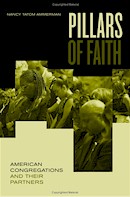|
Organizing Religious Work for the 21st Century
Local Congregations
Our search for emerging patterns took place in seven local
communities. Teams of researchers from universities located in
each site worked with us. They visited a representative sample of
congregations--congregations of all sizes, all religious traditions,
and all ethnic groups. They discovered through interviews and
surveys what work each group consider most important and what resources
and partnerships make that work possible. By combining the
insights from 549 local congregations, we are able to describe the
range of partnerships and resources available to congregations
today. Through subsequent interviews with representatives of
local religious and secular agencies and nonprofits and through
in-depth case studies of a smaller group of representative
congregations, we were able to round out the picture of how religious
people are thinking about who they are, what they should be doing, and
how they do it. [view the list of researchers]
The seven local sites were:
Nashville, Tennessee
Hartford, Connecticut
Albuquerque, New Mexico
rural central Missouri
Seattle, Washington
rural northern Alabama
Chicago, Illinois
Read The Summary Report of findings from the local congregational level of the study by Nancy Ammerman. You may also wish to review her book based on the local findings titled Pillars of Faith.
Area Reports - Individual reports were created for each area
studied in the project. You can view these reports by clicking on
the name of the area. These files are in Adobe pdf format which requires the free Adobe Reader software. If you do not have the free Adobe Acrobat
Reader you can download it from the Adobe web site.
Alabama
Albuquerque
Chicago
Hartford
Missouri
Nashville
Seattle
 Pillars of Faith: American Congregations and Their Partners Pillars of Faith: American Congregations and Their Partners
by Nancy Ammerman
A description of the book:
At the close of the twentieth century the United States was, by all accounts, among the most religious of modern Western nations. Pillars of Faith describes the diversity of tradition and the commonality of organizational strategy that characterize the more than 300,000 congregations in the United States, arguing that they provide the social bonds, spiritual traditions, and community connections that are vital to an increasingly diverse society.
Nancy Tatom Ammerman follows several traditions--Mainline Protestant, Conservative Protestant, African American Protestant, Catholic and Orthodox, Jewish, Sectarian, and other religions--as they establish discernible patterns of congregational life that fit their own history, tradition, and relationship to American society. Her methodologically sophisticated study balances survey research with interviews conducted with people from ninety-one different religious traditions and ethnographic observations that yield new information on many dimensions of American congregational life. Her book is the first to depict the complex resource base supporting American congregations, the enormous web of partners with whom congregations work, and the range of institutional patterns they exhibit.
Contrary to many gloomy forecasts, Pillars of Faith: American Congregations and Their Partners argues that organized religion in the United States is robust and vigorous--and that it can handle the increasing demands of escalating diversity and mobility the future is sure to bring.
|
